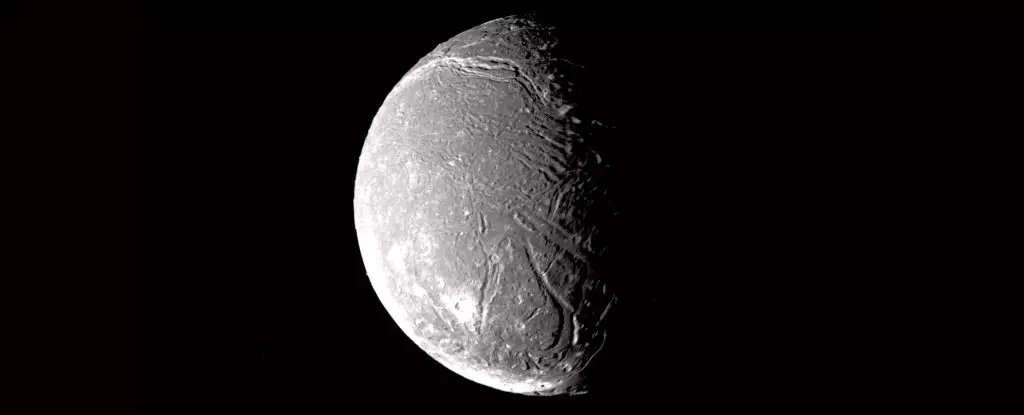The vast expanse of our solar system continues to provoke intrigue with its myriad celestial bodies, each harboring potential secrets waiting to be uncovered. Among these, the moons of the gas giants Jupiter, Saturn, Uranus, and Neptune are particularly captivating. Recent research has illuminated the possibility that some of these moons contain hidden liquid oceans beneath icy crusts. Focusing our lens on Ariel—one of Uranus’ moons—we find a landscape marked by deep chasms that may be key to understanding its internal oceanic dynamics.
The surface of Ariel is a rugged tableau, complete with deep grooves and chasms that appear to etch an intricate story of geological activity. Planetary geologists, such as Chloe Beddingfield from the Johns Hopkins University Applied Physics Laboratory, have noted that the features observed on Ariel could provide valuable insight into the moon’s subsurface composition. Instead of merely being atmospheric phenomena or ice formations, these chasms may serve as channels, allowing materials from Ariel’s interior to vent to the surface. This presents an exciting opportunity for scientists, as it could eliminate the need for invasive exploration methods to understand Ariel’s hidden depths.
One of the most striking elements of Ariel’s topography is its young geological features, characterized by parallel grooves across some chasm floors. The formation of these features is still shrouded in mystery, but they potentially hint at a dynamic internal structure. Traditional theories proposed tectonic or volcanic interactions, but Beddingfield and her colleagues have evaluated whether a process known as “spreading” could explain these geological characteristics better. This concept mirrors seafloor spreading on Earth, wherein warm materials ascend to create new crust.
Understanding how these cracks in Ariel’s icy surface came to be opens doors to deeper geological questions. The proposed mechanism of spreading suggests that warmer materials might rise from the subsurface, creating fissures as they push the ice apart. What makes this theory particularly compelling is that researchers from Beddingfield’s team demonstrated that the edges of the chasms align precisely, akin to zipping up a jacket. This mathematical precision reinforces the notion of active geological processes shaping Ariel’s surface.
Notably, the internal heating within Ariel may not solely derive from the moon’s own geological activity. The moon’s historical orbital resonance with neighboring celestial bodies may also contribute to heating effects through gravitational interactions. These interactions engage the moons in a synchronized ballet, producing the energy necessary to potentially sustain a subsurface ocean. If Ariel does harbor such an ocean, it could be a fascinating reservoir of chemistry, possibly even contributing to the formation of the carbon dioxide ices specifically noted on its surface.
The Ongoing Quest for Exploration
With these revelations, the quest for exploration becomes ever more pertinent. Data from the James Webb Space Telescope (JWST) has hinted at the presence of an ocean deep beneath Ariel’s icy exterior. If this ocean is indeed present, it could fundamentally alter our understanding of the moon’s geology and chemistry. However, addressing the enigma of the carbon deposits and their connection to the chasms remains a priority. Current knowledge is insufficient to link the observed surface ice with the geological features, a puzzle that existing observational tools have yet to resolve.
As the field of planetary science evolves, the case for sending a dedicated exploration mission to Uranus and its moons strengthens. With Ariel’s unique geological formations providing clues to its internal structure, the upcoming missions could unravel the mysteries bound within, not only enriching our comprehension of Ariel itself but also expanding our knowledge of icy moons in general.
Ariel presents a captivating case study in the exploration of extraterrestrial oceans and their connection to geological activity. The nuances of its chasms and the potential for a subsurface ocean render it a prime candidate for future scientific inquiry. As the call for missions to Uranus grows, scientists are poised to unlock secrets that could redefine our understanding of the outer solar system. The time to act is now; let us champion the exploration of these ocean worlds before their mysteries fade into the abyss of the unknown.

